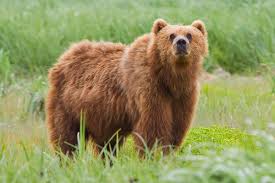Post by dinosauria101 on Feb 17, 2019 18:27:46 GMT 5
Kodiak Bear - Ursus arctos middendorffi
The Kodiak bear (Ursus arctos middendorffi), also known as the Kodiak brown bear, sometimes the Alaskan brown bear, inhabits the islands of the Kodiak Archipelago in southwest Alaska. The largest subspecies are the Kodiak bear (U. a. middendorffi) and the questionably distinct peninsular or coastal brown bear (U. a. gyas). Once mature, the typical female Kodiak bear can range in body mass from 120 to 318 kg (265 to 701 lb) and while from sexual maturity onward the male from 168 to 675 kg (370 to 1,488 lb), averaging 312 kg (686 lb).

Giraffe - Giraffa camelopardalis
The giraffe (Giraffa camelopardalis) is an African even-toed ungulate mammal, the tallest living terrestrial animal and the largest ruminant. Its specific name refers to its camel-like face and patches of color on a light background, which bear a vague resemblance to a leopard's spots. The giraffe is also noted for its extremely long neck and legs and prominent horns. It stands 5–6 m (16–20 ft) tall and has an average weight of 1,300 kg (2,820 lb) for males and 830 kg (1,800 lb) for females. It is classified under the family Giraffidae, along with its closest extant relative, the okapi. There are nine subspecies, which differ in size, coloration, pattern, and range. The giraffe's scattered range extends from Chad in the north to South Africa in the south and from Niger in the west to Somalia in the east. Giraffes usually inhabit savannas, grasslands, and open woodlands. They prefer areas with plenty of acacia trees, which are important food sources, and can browse at heights that most other herbivores cannot reach. While adults are nearly invulnerable to predation, lions, leopards, spotted hyenas and wild dogs prey on calves. Giraffes commonly gather in aggregations that usually disband every few hours. Males establish social hierarchies through "neckings", which are combat bouts where the neck is used as a weapon. Dominant males gain mating access to females, who bear the sole responsibility for raising the young.

Credit to Wikipedia
The Kodiak bear (Ursus arctos middendorffi), also known as the Kodiak brown bear, sometimes the Alaskan brown bear, inhabits the islands of the Kodiak Archipelago in southwest Alaska. The largest subspecies are the Kodiak bear (U. a. middendorffi) and the questionably distinct peninsular or coastal brown bear (U. a. gyas). Once mature, the typical female Kodiak bear can range in body mass from 120 to 318 kg (265 to 701 lb) and while from sexual maturity onward the male from 168 to 675 kg (370 to 1,488 lb), averaging 312 kg (686 lb).
Giraffe - Giraffa camelopardalis
The giraffe (Giraffa camelopardalis) is an African even-toed ungulate mammal, the tallest living terrestrial animal and the largest ruminant. Its specific name refers to its camel-like face and patches of color on a light background, which bear a vague resemblance to a leopard's spots. The giraffe is also noted for its extremely long neck and legs and prominent horns. It stands 5–6 m (16–20 ft) tall and has an average weight of 1,300 kg (2,820 lb) for males and 830 kg (1,800 lb) for females. It is classified under the family Giraffidae, along with its closest extant relative, the okapi. There are nine subspecies, which differ in size, coloration, pattern, and range. The giraffe's scattered range extends from Chad in the north to South Africa in the south and from Niger in the west to Somalia in the east. Giraffes usually inhabit savannas, grasslands, and open woodlands. They prefer areas with plenty of acacia trees, which are important food sources, and can browse at heights that most other herbivores cannot reach. While adults are nearly invulnerable to predation, lions, leopards, spotted hyenas and wild dogs prey on calves. Giraffes commonly gather in aggregations that usually disband every few hours. Males establish social hierarchies through "neckings", which are combat bouts where the neck is used as a weapon. Dominant males gain mating access to females, who bear the sole responsibility for raising the young.

Credit to Wikipedia


